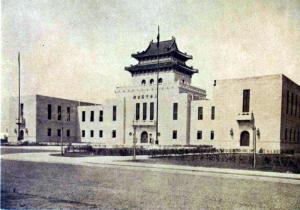Posted: December 28th, 2014 | 1 Comment »
Nathaniel Scobie’s new graphic novel, The Cat with the Telltale Tattoo, features a Shanghai Municipal copper who’s a cat, Constable Khang, solving crimes in old Shanghai. It’s influenced by Tin Tin and, perhaps, Lao She’s Cat Country too I guess. It looks fun anyway and there’s an interview with the artist/author here. This seems to be the only place to get the book.
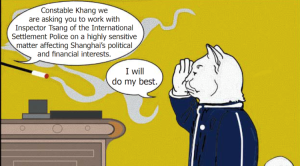
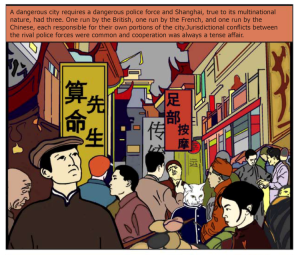
Posted: December 27th, 2014 | 4 Comments »
A few weeks ago I blogged about the French writer Maurice Dekobra and his novel Macao: L’enfer du jeu. Dekobra was unknown to me until recently, but now, having read a bunch of his books I think of him as a sort of French version of Arnold Bennett with a bit of Somerset Maugham thrown in. Dekobra spent some time in China and around the Far East and wrote a number of books set in the East, though most of his work was set in his native France. However, traces of the East constantly appear in his French-set novels. Here’s a passage from his novel Midnight on the Place Pigalle (hard not like a writer who uses Midnight in his title!) published in 1932 and concerning a young man who has been thoroughly corrupted by being introduced to sex and the cabaret culture of Pigalle in Paris in the 1920s…
‘True, I have had a liaison with a little English dancer named Molly. She had a friend, and they insisted on my smoking opium. After Molly, I had an affaire with the wife of a banker who was addicted to flagellation. She initiated me by degrees in anima vili to the theories of Sacher Masoch…and the last month or so I tried cocaine with a literary lady, who consumed two dessertspoonfuls a week, and who handed me over to the tender care of a little Annamite, newly arrived from Saigon.’

Antoine Blanchard’s Place Pigalle

Posted: December 26th, 2014 | No Comments »
Another year, another round up of references to opium in popular culture (see the 2013 and 2012 roundups for previous dope in popular culture).
 Tommy’s off the dope it seems – no wonder he’s getting a bit violent with those Sabini boys
Tommy’s off the dope it seems – no wonder he’s getting a bit violent with those Sabini boys
Lucy Worsley’s BBC series A Very British Murder, on the history of popular fascination and books about murder in Britain, kicked off with the presenter in Thomas de Quincey’s old place in Grassmere, in the lovely Lake District, showing us his opium paraphernalia. In Mike Leigh’s Mr Turner we also found out that the artist partook of a drop of laudanum for his ailments. Elsewhere on TV series 2 of Peaky Blinders was excellent, but Tommy Sheridan appears instantly cured of his series 1 opium addiction and Birmingham Chinatown didn’t feature again – still, this time round, we got swells tooting coke in a Sabini-family-run London 1920s nightclub, so all was not lost! (and see my post on tooting ‘Tokyo” in 1920s London here). Showtime and Sky’s Penny Dreadful did not disappoint and had us in a candlelit East End opium den within the first fifteen minutes of episode 1 and poor sweet Brona Croft (Billie Piper) on the laudanum later!! At the theatre Lynn Nottage’s play Intimate Apparel played in the UK to good reviews. Centred around a seamstress in 1905 New York, she ends up married to an opium addict.

Penny Dreadful’s Sir Malcolm Murray steps into a Limehouse dope den
In books London historian and novelist Peter Ackroyd had some mentions of Limehouse as a slum in the 1960s and as a rookery of opium dens back in the day in Three Brothers while Laura Wilson’s DI Stratton had a morphine murder during World War Two London on his hands in An Empty Death. Robert Edric’s The Monster’s Lament saw good old Aleister Crowley on a little dope in war-time London (and make a couple of mentions of his Shanghai sojourn too). According to The Monster’s Lament Crowley’s preferred tipple was ten grains of opium taken with brandy! Opium also makes a small appearance in Adrian McKinty’s interesting The Sun is God, a tru-ish story of a murderous German cult living on the Kaiser’s far flung Pacific island colonies at the start of the twentieth century. Somewhat of a curiosity from McKinty (who usually does more modern noirs about Northern Ireland and Irish-New York), but a fascinating tale all the same. Sarah Waters hinted at 1920s London cocaine party goings on in The Paying Guests, and Lawrence Osborne had a washed up English gambling addict sucking the pipe for relief on Lamma Island in his excellent The Ballad of a Small Player. And, last but never, ever least, the excellent James Ellroy opted to include a few opium den scenes in just pre-war 2 LA in Perfidia,Â

Posted: December 25th, 2014 | No Comments »
Posted this last year….but it’s worth a second outing….
Many thanks to an old time Shanghailander, Bill Savadove, who sent me this card originally sent in 1945 from Shanghai by the United States Navy wishing the folks back home a “melly klisimas”…..
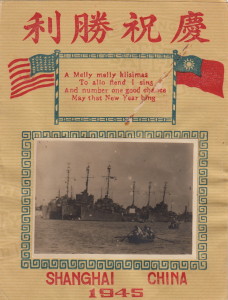

Posted: December 24th, 2014 | No Comments »

Posted: December 23rd, 2014 | No Comments »
Aaahh, how lovely – Shanghai Honeymoon, a minor hit of 1926 with words and music by William l Shockley, Charles J Hausman and Lester Melrose and with the tagline, “The First Original Melody in Yearsâ€. The singers, pictured in the moon, are Esther and Cecil Ward, who both happened to be adept on the Hawaiian guitar and were big on the American radio bran dance circuit.
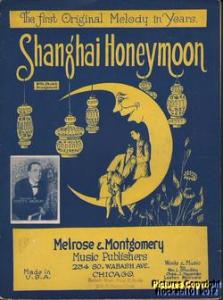
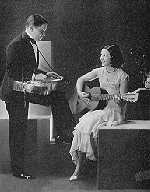
Esther and Cecil with their Hawaiian guitars
Posted: December 22nd, 2014 | No Comments »
Jie Li’s Shanghai Homes looks like a useful read and remiss of me not to have mentioned it previously – just made the Guardian’s Top Ten City Books for 2014….
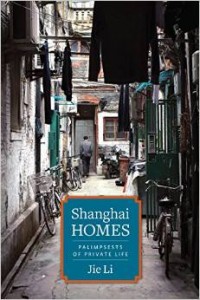
In the dazzling global metropolis of Shanghai, what has it meant to call this city home? In this account — part microhistory, part memoir — Jie Li salvages intimate recollections by successive generations of inhabitants of two vibrant, culturally mixed Shanghai alleyways from the Republican, Maoist, and post-Mao eras. Exploring three dimensions of private life — territories, artifacts, and gossip — Li re-creates the sounds, smells, look, and feel of home over a tumultuous century. First built by British and Japanese companies in 1915 and 1927, the two homes at the center of this narrative were located in an industrial part of the former “International Settlement.” Before their recent demolition, they were nestled in Shanghai’s labyrinthine alleyways, which housed more than half of the city’s population from the Sino-Japanese War to the Cultural Revolution. Through interviews with her own family members as well as their neighbors, classmates, and co-workers, Li weaves a complex social tapestry reflecting the lived experiences of ordinary people struggling to absorb and adapt to major historical change. These voices include workers, intellectuals, Communists, Nationalists, foreigners, compradors, wives, concubines, and children who all fought for a foothold and haven in this city, witnessing spectacles so full of farce and pathos they could only be whispered as secret histories.
Posted: December 21st, 2014 | No Comments »
Thanks to Shanghai street photographer Bon Wen for sending me a link to his excellent photos of the old Shanghai library – not the better known old race course building (on the corner of Nanjing West Road and Huangpi Road), which was, for a long time, the Shanghai library, or the monstrosity they built on Huai Hai Road which resembles a courthouse-cum-maxi-prison and is largely designed to discourage anyone wandering in and looking for a book. No, this is the Shanghai library in Jiangwan, built in 1934-35, and part of the futuristic planned civic centre for China-administered Shanghai. If you’ve not been (and surprisingly few people do) then go immediately – subway line 10 to Jiangwan Stadium.
Now the inevitable sad story of the building – first a library built by the Nationalist government and stocked full of books – good thing. Then the communists took out all the books (too many they disagreed with) and turned it into Tongji Middle School – shame about the books but worse things than a school. Then the post-communist leaders of today’s philistines threw the school out and let the building rot.
Click here to see Bon Wen’s photographs of the dereliction of the once fine structure and some images of the original (as below)…a real shame.
